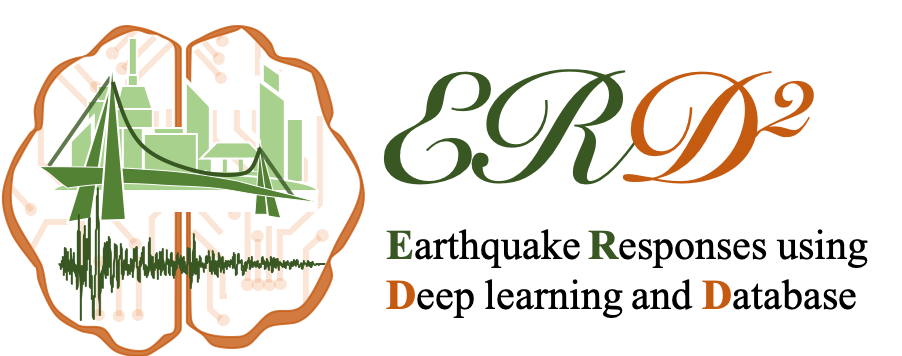
Structural failures caused by a strong earthquake may induce a large number of casualties and huge economic losses. To enhance life safety and disaster-resilience of communities, a structure should be designed to withstand a design level earthquake event for which nonlinear response history analyses (NRHA) are necessary. However, the NRHA requires a large computational cost to be applied in routine engineering practice. There exist several simplified analysis methods which can substitute NRHA such as capacity spectrum method in FEMA 440 (2005), coefficient method in ASCE 41-13 (2013) or traditional R-mu-T relationships. These simplified methods are approximate methods which is largely based on equivalent linearization and/or regression analysis of many single-degree-of-freedom (SDOF) analysis results. Consequently, the simplified method has limited accuracy in comparison with NRHA.
To overcome the limitation, the developers constructed a seismic demand database of nonlinear hysteretic systems by performing over 300 thousand dynamic analyses using OpenSees. In the current version three different hysteretic models are included. The database is expected to grow as more time history analyses are carried out with diverse hysteretic models. In addition, a model with which seismic demands can be predicted has been developed based on deep neural network.
This website provides an access to the seismic demand database and the deep neural network to evaluate seismic demand of nonlinear hysteretic systems. Users can download pre-calculated displacement, velocity, and acceleration of a specific structural model subjected to ground motions whose M (with M range) and R (with R range) are included in the user-defined range. Using the deep neural network, the peak displacement, velocity, and acceleration of a specific structural model can be probabilistically estimated based on a set of parameters that user provide.
In order to construct the database, a structural model and recorded ground motions are needed. The ground motions from NGA West database (Power et al. 2006) is employed and the different hysteretic models which are widely used in the field of civil engineering: linear elastic, bilinear kinematic hardening, and bilinear stiffness degrading SDOF systems are used. To cover broad range of characteristics of practical structures, 90 steps of structural period from 0.05 sec to 10 sec, 30 steps of yield strength from 0.05 g to 1.5 g, and 10 steps of post yield stiffness ratio from 0 to 0.5 were selected, which are determined based on the capacity curves in HAZUS-MH 2.1 (FEMA 2012). The database is constructed with SQLite3.


A new deep neural network architecture is proposed by the developers to predict seismic demands of various SDOF systems without running nonlinear response history analysis. Magnitude, distance, soil class, PGA, PGV, PGD, and response spectrum, are used as input parameters which characterize input ground motion. The structural characteristic is defined as cyclic pushover curve which is formatted as two column data (i.e. displacement and force). Convolutional neural network which has been developed to abstract features from visual imagery is adopted to abstract features from the cyclic pushover curve. The proposed deep neural network architecture outputs the conditional mean and variance of the structural responses given the inputs.
This website was developed by Taeyong Kim, Oh-Sung Kwon, and Junho Song. The data and the algorithm in the background of the website is based on the two journal papers coauthored by the developers. The homepage will be updated the model is further developed by expanding the seismic demand database or further training of the deep neural network model. The developers greatly appreciate Mr. Tarun Singhal for his help on the development of this website. All codes and database are uploaded on Github. If you have questions, please contact Taeyong Kim.
1. The International Research and Development Program of the National Research Foundation of Korea (NRF) funded by the Ministry of Science, ICT and Future Planning (Grant number: 2017K1A3A1A12034682)
2. Mitacs Globalink Research Award
3. The Korean Federation of Science and Technology Societies (KOFST) grant funded by the Korean government (MSIP: Ministry of Science, ICT and Future Planning)
4. The Institute of Engineering Research at Seoul National University and the project “Development of Life-cycle Engineering Technique and Construction Method for Global Competitiveness Upgrade of Cable Bridges” of the Ministry of Land, Infrastructure and Transport (MOLIT) of the Korean Government (Grant No. 16SCIP-B119960-01).
Finally, this research was enabled in part by support provided by WestGrid (www.westgrid.ca) and Compute Canada (www.computecanada.ca). Any opinions, findings, and conclusions expressed in this paper are those of the developers, and do not necessarily reflect the views of the sponsors.
1. Kim, T., Kwon, O., Song, J. (2019) Response Prediction of Nonlinear Hysteretic Systems by Deep Neural Networks, Neural Networks. Neural Networks. Vol. 111, 1-10.
2. Kim, T., Song, J., Kwon, O. (2019) Probabilistic Estimation of Seismic Responses with Deep Neural Networks. Structural Safety Vol. 84, 101913.
3. Kim, T., Song, J., Kwon, O. (2020) Pre- and post-earthquake regional loss assessment using deep learning. Earthquake Engineering and Structural Dynamics.49: 657– 678.
4. Kim, T., Kwon, O., Song, J. (2023) Deep learning-based seismic response prediction of hysteretic systems having degradation and pinching. Earthquake Engineering and Structural Dynamics.
5. ASCE (2013) Seismic Evaluation and Rehabilitation of Existing Buildings, ASCE/SEI 41-13 (Public Comment Draft), American Society of Civil Engineers, Reston, VA.
6. ATC (2005) Improvement of Nonlinear Static Seismic Analysis Procedures. Rep. No. FEMA-440, Washington, D.C.
7. Power, M., Chiou, B., Abrahamson, N., Roblee C. (2006) The “Next Generation of Ground Motion Attenuation Models” (NGA) Project: An Overview. In Proceedings, Eighth National Conference on Earthquake Engineering, Paper No. 2022.
© Copyright 2023, Taeyong Kim
Ajou University, Seoul National University, and University of Toronto